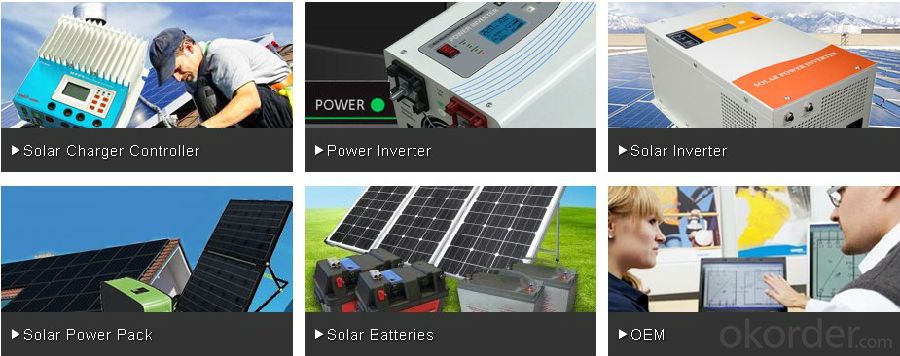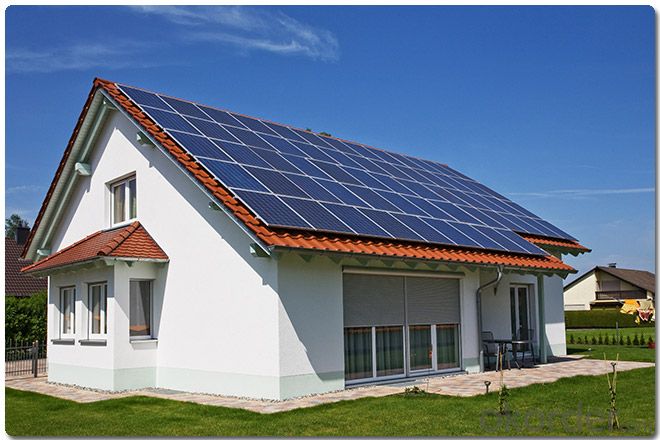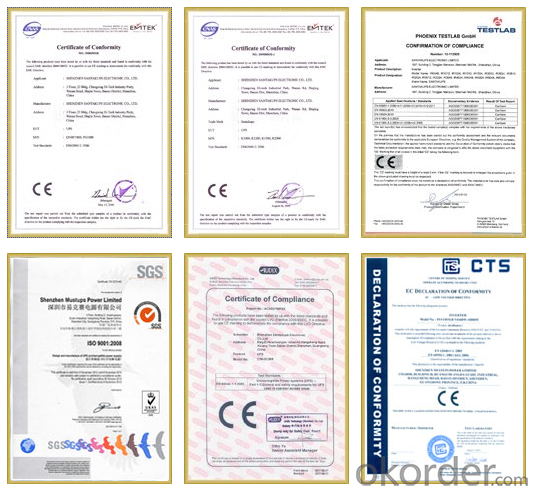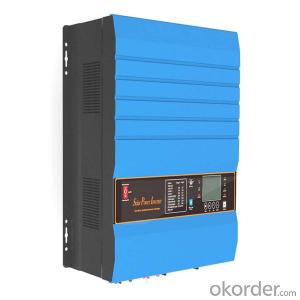10KW Pure Sine Wave Inverter New Function PV3500 Series 48V
- Loading Port:
- China main port
- Payment Terms:
- TT or LC
- Min Order Qty:
- 50 pc
- Supply Capability:
- 10000 pc/month
OKorder Service Pledge
OKorder Financial Service
You Might Also Like
Advances of Solar Inverter 10KW Pure Sine Wave Inverter New Function PV3500 Series 48V
Our solar inverters typically transfer to battery power in less than 16 milliseconds (less than 1/50th of a second).
Our solar backup electric systems use special high-quality electric storage batteries.
Main Features of Solar Inverter 10KW Pure Sine Wave Inverter New Function PV3500 Series 48V
.Power range 1kw-112kw
.12/24v/48v input optional
.Powerful Charge Rate Up to 100Amp
.Inbuilt pure copper transformer
.Pure sine wave output
.LED+LCD display
.MPPT solar charge controller 40A 45A 60A
.50/60HZ automatic sensing
.RS232 with free CD
.Battery priority function
.DC Start & Automatic Self-Diagnostic Function
.High Efficiency Design & “Power Saving Mode” to Conserve Energy
Specificationsc of Solar Inverter 10KW Pure Sine Wave Inverter New Function PV3500 Series 48V
Solar Inverter Model | 1.0KW | 1.5KW | 2.0KW | 3.0KW | 4.0KW | 5.0KW | 6.0KW | 8.0KW | 10.0KW | 12.0KW | |
Inverter output | Continuous output power | 1.0KW | 1.5KW | 2.0KW | 3.0KW | 4.0KW | 5.0KW | 6.0KW | 8.0KW | 10.0KW | 12.0KW |
Surge rating (20ms) | 3.0KW | 4.5KW | 6.0KW | 9.0KW | 12.0KW | 15.0KW | 18.0KW | 24.0KW | 30.0KW | 36.0KW | |
Output waveform | Pure sine wave/ same as input (bypass mode) | ||||||||||
Nominal efficiency | >88% (peak) | ||||||||||
Line mode efficiency | >95% | ||||||||||
Power factor | 0.9-1.0 | ||||||||||
Nominal output voltage RMS | 100-110-120VAC/220-230-240VAC | ||||||||||
Output voltage regulation | ±10% RMS | ||||||||||
Output frequency | 50Hz ± 0.3Hz / 60Hz ± 0.3Hz | ||||||||||
Short circuit protection | Yes (1sec after fault) | ||||||||||
Typical transfer time | 10ms (max) | ||||||||||
THD | < 10% | ||||||||||
DC input | Nominal input voltage | 12.0VDC / 24.0VDC / 48.0VDC | 24.0VDC /48.0VDC | 48.0VDC | |||||||
Minimum start voltage | 10.0VDC /10.5VDC for12VDC mode | *2 for 24VDC, *4 for 48VDC | |||||||||
Low battery alarm | 10.5VDC /11.0VDC for12VDC mode | ||||||||||
Low battery trip | 10.0VDC /10.5VDC for12VDC mode | ||||||||||
High voltage alarm | 16.0VDC for12VDC mode | ||||||||||
Low battery voltage recover | 15.5VDC for12VDC mode | ||||||||||
Idle consumption-search mode | <25W when power saver on. (refer to table) | ||||||||||
Charger | Output voltage | Depends on battery type (refer to table 2.5.2) | |||||||||
Charger breaker rating | 10A | 15A | 20A | 20A | 20A | 30A | 30A | 40A | 40A | 40A | |
Max charge power rate | 1/3 Rating power (refer to table 2.5.3) | ||||||||||
Battery initial voltage for start | 10-15.7VDC for 12VDC mode | *2 for 24VDC, *4 for 48VDC | |||||||||
Over charge protection S.D. | 15.7VDC for 12VDC mode | ||||||||||
BTS | Battery temperature sensor (optional) | Yes (refer to the table) Variances in charging voltage & S.D. voltage base on the battery temperature. | |||||||||
Bypass & protection | Input voltage waveform | Sine wave (grid or generator) | |||||||||
Nominal voltage | 110VAC | 120VAC | 220VAC | 230VAC | 230VAC | ||||||
Max input AC voltage | 150VAC for 120VAC LV mode; 300VAC for 230VAC HV mode. | ||||||||||
Nominal input frequency | 50Hz or 60Hz | ||||||||||
Low freq trip | 47 ± 0.3Hz for 50Hz; 57 ± 0.3Hz for 60Hz | ||||||||||
High freq trip | 55 ± 0.3Hz for 50Hz; 65 ± 0.3Hz for 60Hz | ||||||||||
Overload protection (SMPS load) | Circuit breaker | ||||||||||
Output short circuit protection | Circuit breaker | ||||||||||
Bypass breaker rating | 10 | 15 | 20 | 30 | 40 | 40 | 40 | 50 | 63 | 63 | |
Transfer switch rating | 30Amp for UL & TUV | 40Amp for UL | 80Amp for UL | ||||||||
Bypass without battery connected | Yes (optional) | ||||||||||
Max bypass current | 30Amp | 40Amp | 80Amp | ||||||||
Solar charger | Rated voltage | 12.0VDC / 24.0VDC / 48.0VDC | |||||||||
Solar input voltage range | 15-30VDC / 30-55VDC / 55-100VDC | ||||||||||
Rated charge current | 40-60A | ||||||||||
Rated output current | 15A | ||||||||||
Self consumption | <10mA | ||||||||||
Bulk charge (default) | 14.5VDC for12VDC mode | *2 for 24VDC, *4 for 48VDC | |||||||||
Floating charge (default) | 13.5VDC for12VDC mode | ||||||||||
Equalization charge (default) | 14.0VDC for12VDC mode | ||||||||||
Over charge disconnection | 14.8VDC for12VDC mode | ||||||||||
Over charge recovery | 13.6VDC for12VDC mode | ||||||||||
Over discharge disconnection | 10.8VDC for12VDC mode | ||||||||||
Over discharge reconnection | 12.3VDC for12VDC mode | ||||||||||
Temperature compensation | -13.2mVDC/℃ for12VDC mode | ||||||||||
Ambient temperature | 0-40℃ (full load) 40-60℃ (derating) | ||||||||||
Mechanical specifications | Mounting | Wall mount | |||||||||
Inverter dimensions (L*W*H) | 388*415*200mm | 488*415*200mm | 588*415*200mm | ||||||||
Inverter weight (solar chg) KG | 21+2.5 | 22+2.5 | 23+2.5 | 27+2.5 | 38+2.5 | 48+2.5 | 49+2.5 | 60+2.5 | 66+2.5 | 70+2.5 | |
Shipping dimensions (L*W*H) | 550*520*310mm | 650*520*310mm | 750+520+310mm | ||||||||
Shipping weight (solar chg) KG | 23+2.5 | 24+2.5 | 25+2.5 | 29+2.5 | 40+2.5 | 50+2.5 | 51+2.5 | 62+2.5 | 68+2.5 | 72+2.5 | |
Display | LED+LCD | ||||||||||
Standard warranty | 1 year | ||||||||||
Pictures of Solar Inverter 10KW Pure Sine Wave Inverter New Function PV3500 Series 48V

Solar Inverter's Application

Warranty of Solar Inverter 10KW Pure Sine Wave Inverter New Function PV3500 Series 48V
OKorder’s Products provides a 1~3 year limited warranty (“Warranty”) against defects in materials and workmanship for its Uninterruptible power supply, Power inverter/chargers, Solar charge controllers, Battery Products (“Product”).
The term of this Warranty begins on the Product(s) initial purchase date, or the date of receipt of the Product(s) by the end user, whichever is later.
This must be indicated on the invoice, bill of sale, and/or warranty registration card submitted to MUST-Solar.
This Warranty applies to the original MUST-Solar Product purchaser, and is transferable only if the Product remains installed in the original use location.
Certificates of Solar Inverter 10KW Pure Sine Wave Inverter New Function PV3500 Series 48V

FAQ of Solar Inverter 10KW Pure Sine Wave Inverter New Function PV3500 Series 48V
How to guarantee the quality of the products?
We have established the international advanced quality management system,every link from raw material to final product we have strict quality test;
We resolutely put an end to unqualified products flowing into the market.
At the same time, we will provide necessary follow-up service assurance.
How long can we receive the product after purchase?
In the purchase of product within three working days, We will arrange the factory delivery as soon as possible.
- Q:Can a solar inverter be used with solar-powered air conditioning systems?
- Yes, a solar inverter can be used with solar-powered air conditioning systems. The solar inverter is responsible for converting the direct current (DC) generated by the solar panels into alternating current (AC) that can be used to power various electrical appliances, including air conditioning units. By connecting the solar inverter to the solar panels and the air conditioning system, the generated solar energy can be efficiently utilized to power the AC system.
- Q:How does a solar inverter handle grid islanding conditions?
- A solar inverter detects grid islanding conditions by monitoring the voltage and frequency of the grid. When it detects a deviation from the normal range, indicating an islanding event, it immediately stops supplying power to the grid. This is done to ensure the safety of utility workers who may be repairing the grid.
- Q:What is the role of a solar inverter in a solar-powered desalination system?
- The role of a solar inverter in a solar-powered desalination system is to convert the direct current (DC) generated by the solar panels into alternating current (AC) that can be used to power the desalination equipment. It ensures the efficient utilization of solar energy by transforming it into a usable form for the desalination process.
- Q:Can a solar inverter be used with a time-of-use electricity tariff?
- Yes, a solar inverter can be used with a time-of-use electricity tariff. Time-of-use electricity tariffs typically involve different rates for electricity consumption based on the time of day. A solar inverter can be programmed to produce and export excess solar energy during peak times when electricity rates are higher, and import energy from the grid during off-peak times when rates are lower. This allows users to optimize their energy consumption and potentially save on electricity costs.
- Q:What is the difference between a transformerless inverter and a transformer-based inverter?
- A transformerless inverter does not include a transformer in its design, while a transformer-based inverter incorporates a transformer as an integral component. The main difference lies in their electrical isolation capabilities and overall system efficiency. Transformerless inverters use circuitry to achieve electrical isolation, which can result in higher efficiency and reduced size. On the other hand, transformer-based inverters employ a physical transformer for isolation, which offers better safety and protection against electrical noise and voltage fluctuations.
- Q:Are there any fire safety concerns associated with solar inverters?
- Solar inverters do pose some fire safety concerns. Although they are not typically a fire hazard themselves, there are a few potential risks to be aware of. Firstly, if the solar inverter is installed incorrectly, it can cause electrical problems that may lead to a fire. To prevent this, it is essential to hire a qualified and certified professional who can ensure that all electrical connections are secure and meet the necessary standards. Secondly, if the solar inverter is located in an area that experiences high temperatures or excessive heat, there is a risk of overheating. Inverters generate heat as they convert direct current (DC) from solar panels into alternating current (AC) for use in homes or businesses. If the inverter is not adequately ventilated or is exposed to extreme heat, it can overheat and potentially ignite a fire. Furthermore, if the inverter is faulty or damaged, it can increase the risk of fire. Regular maintenance and inspections of the solar inverter can help identify any potential issues and ensure its safe operation. To address these fire safety concerns, it is crucial to adhere to proper installation guidelines, regularly inspect and maintain the inverter, and ensure it is in a well-ventilated location away from sources of excessive heat. It is also advisable to have a fire extinguisher nearby and establish a fire safety plan in case of emergencies.
- Q:Can a solar inverter be used in areas with limited roof space or installation options?
- Yes, a solar inverter can be used in areas with limited roof space or installation options. Solar inverters are typically compact and can be installed in various locations, such as the ground, walls, or even inside the house. In addition, there are different types of solar inverters available, including microinverters and power optimizers, which allow for more flexibility in system design and installation. These options can help maximize the use of available space and provide more installation options for areas with limited roof space.
- Q:What is the role of a galvanic isolation transformer in a solar inverter?
- The role of a galvanic isolation transformer in a solar inverter is to provide electrical isolation between the input (solar panels) and the output (power grid). This isolation helps in preventing any electrical noise, surges, or ground loops from affecting the solar inverter or the power grid, ensuring safe and reliable operation. Additionally, the galvanic isolation transformer helps in maintaining the required level of insulation and protection, complying with safety standards and regulations.
- Q:What are the key factors affecting the reliability of a solar inverter?
- The key factors affecting the reliability of a solar inverter include the quality and durability of its components, such as the semiconductor devices, capacitors, and transformers. The design and manufacturing processes also play a significant role, as well as the overall system integration and installation. The environmental conditions, such as temperature, humidity, and dust levels, can impact the inverter's reliability, along with the quality of the electrical grid and the stability of the solar power generation. Regular maintenance and monitoring are crucial for identifying and addressing any potential issues that may arise, ensuring the long-term reliability of the solar inverter.
- Q:What is the role of a solar inverter in grid management and stability?
- The role of a solar inverter in grid management and stability is crucial in integrating solar power into the existing electrical grid system. Solar inverters are responsible for converting the direct current (DC) electricity generated by solar panels into alternating current (AC) electricity that can be used by homes and businesses or fed back into the grid. In terms of grid management, solar inverters play a vital role in maintaining the stability and reliability of the electrical grid. They provide grid support functions such as voltage regulation, frequency control, and reactive power compensation. By monitoring the grid conditions and adjusting the output of solar power accordingly, inverters help to balance the supply and demand of electricity in real-time, ensuring grid stability. Solar inverters also contribute to grid stability by improving power quality. They actively filter out harmonics, voltage fluctuations, and other electrical disturbances that can be caused by the intermittent nature of solar power generation. This ensures that the electricity generated by solar panels is of high quality and does not introduce any disruptions or damage to the electrical grid. Furthermore, solar inverters enable the seamless integration of solar power into the grid, allowing excess energy to be fed back into the system. This is known as net metering or feed-in tariff programs, where solar energy producers can receive compensation for the surplus electricity they produce. With the help of inverters, the generated solar energy can be efficiently transferred to the grid, reducing the reliance on traditional fossil fuel-based power generation and promoting renewable energy integration. Overall, the role of a solar inverter in grid management and stability is to ensure the smooth integration and optimal utilization of solar power, while maintaining the stability, reliability, and quality of the electrical grid. It acts as a bridge between solar energy producers and the grid, facilitating the efficient and sustainable integration of renewable energy sources into the existing power infrastructure.
1. Manufacturer Overview |
|
|---|---|
| Location | |
| Year Established | |
| Annual Output Value | |
| Main Markets | |
| Company Certifications | |
2. Manufacturer Certificates |
|
|---|---|
| a) Certification Name | |
| Range | |
| Reference | |
| Validity Period | |
3. Manufacturer Capability |
|
|---|---|
| a)Trade Capacity | |
| Nearest Port | |
| Export Percentage | |
| No.of Employees in Trade Department | |
| Language Spoken: | |
| b)Factory Information | |
| Factory Size: | |
| No. of Production Lines | |
| Contract Manufacturing | |
| Product Price Range | |
Send your message to us
10KW Pure Sine Wave Inverter New Function PV3500 Series 48V
- Loading Port:
- China main port
- Payment Terms:
- TT or LC
- Min Order Qty:
- 50 pc
- Supply Capability:
- 10000 pc/month
OKorder Service Pledge
OKorder Financial Service
Similar products
New products
Hot products
Hot Searches
Related keywords































